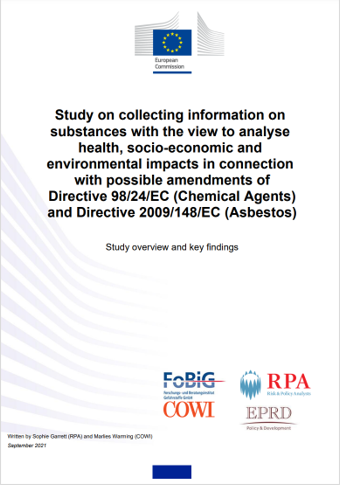Study on collecting information on substances with possible amendments of Directive Chemical Agents and Asbestos
| ID 15239 | | Visite: 1312 | Documenti Sicurezza UE | Permalink: https://www.certifico.com/id/15239 |
Study on collecting information on substances with possible amendments of Directive Chemical Agents and Asbestos
ID 15239 | 23.12.2021
Study on collecting information on substances with the view to analyse health, socio-economic and environmental impacts in connection with possible amendments of Directive 98/24/EC (Chemical Agents) and Directive 2009/148/EC (Asbestos)
This report summarises the key findings from four reports written within the framework of a study commissioned by the European Commission, Directorate-General for Employment, Social Affairs and Inclusion (DG EMPL) by a consortium comprising RPA (Risk & Policy Analysts) (United Kingdom), COWI A/S (Denmark), FoBiG (Forschungsund Beratungsinstitut Gefahrstoffe) (Germany), and EPRD (Office for Economic Policy and Regional Development) (Poland).
The four reports are:
- Report for lead and its compounds;
- Report for asbestos;
- Report for diisocyanates; and
- Methodological note.
Ensuring a safe and healthy work environment for over 200 million workers in the EU is an ongoing strategic goal for the European Commission according to the Communications from the Commission on the EU Strategic Framework on Health and Safety at Work 2014 – 20201 and 2021 20272. Cancer and other work-related health problems caused by exposure to carcinogenic and other hazardous chemical substances at the workplace leads to suffering of workers and their caring families. It reduces the length, quality, and productivity of the working lives of European workers. It is important to ensure that risks to workers' health that arise from exposure to carcinogenic and other hazardous chemicals at the workplace are effectively controlled including, where appropriate, by the use of limit values.
Fonte: EC
Collegati
| Descrizione | Livello | Dimensione | Downloads | |
|---|---|---|---|---|
| Study on collecting information on substances with possible amendments of Directive Chemical Agents and Asbestos.pdf CE 2021 |
574 kB | 5 |
Tags: Sicurezza lavoro Rischio chimico Rischio amianto Abbonati Sicurezza
